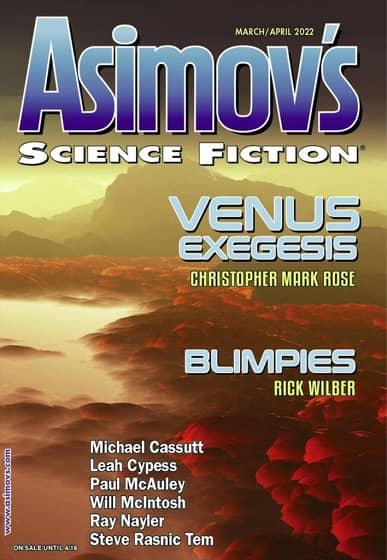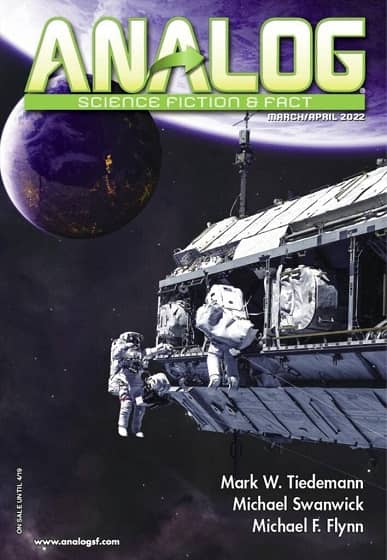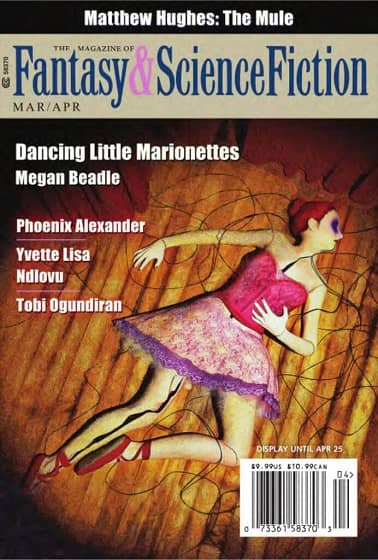Spider-Societies, Alien Structures, and Grim Wastelands: March/April 2022 Print SF Magazines
 |
 |
 |
March/April 2022 issues of Asimov’s Science Fiction, Analog Science Fiction & Fact, and The
Magazine of Fantasy & Science Fiction. Cover art by Shutterstock, 123RF, and Mondolithic Studios
One of the bennies of digital publishing is the luxury of enjoying magazine reviews while the magazines are still on the shelves. I haven’t purchased the March/April F&F yet, for example, but my interest has been sharpened by reviews like this one, by C.D. Lewis at Tangent Online, for Tobi Ogundiran’s “The Epic of Qu Shittu.”
[It] opens on a stowaway sneaking into the ship’s hold of a deadly enchanter in the hope of meeting the legend himself. What could possibly go wrong? Ogundiran’s language makes it a pleasure to read room descriptions; horror and humor meet in descriptions of “skulls wearing identical smiles as if sharing some secret joke…” The story elements laid before the reader support so many directions it’s not initially clear whether “The Epic of Qu Shittu” will turn out to be a tragedy, a heist, a revenge plot, or something else; it’s an exciting read that adds psychological elements and moral problems to the physical conflicts.
The March/April print magazines contain stories by Matthew Hughes, Adriana C. Grigore, Ray Nayler, Will McIntosh, Marta Randall, Paul McAuley, Steve Rasnic Tem, William Ledbetter, Mark W. Tiedemann, Michael Swanwick, Alvaro Zinos-Amaro, Michael F. Flynn, and many others.
Paul Fraser has been posting daily short fiction reviews on his blog SF Short Stories… Reviewed, and he teases Michael Swanwick’s short story “Nirvana or Bust” in the March-April Analog nicely:
“Nirvana or Bust”… opens with an exo-skeleton wearing woman called Huiling dangling her feet into the Grand Canyon when she is found by another woman called Catherine McClury. McClury tells Huiling that an assassin is coming for her….
When (spoiler) the politely spoken assassin (“a chromed mantisform a good seven feet tall”) arrives, it tells Huiling that it is there to communicate and reason with her (although it concludes these opening remarks with the observation that murder is a form of communication!) Then we get to the meat of the story, which is that Huiling and Nirvana or Bust are a merged being, something between symbionts and a complete union. When the assassin confirms this is the case — during the interview it asks Nirvana or Bust why an AI would do this — it states that they must die.
Read Fraser’s full review here.
Mike Bickerdike at Tangent Online has a more detailed review of the new Analog; here’s the highlights.
The novella “Exile’s Grace” by Mark W. Tiedemann kicks off the issue in sterling form, offering a superior hard SF story set on a distant alien world. A crewman, stuck on an orbiting space-station while his ship gets necessary maintenance, discovers quite by chance that an old friend is living on the planet below, in an exiled or hermit-like manner. When he goes down to the planet to investigate, he discovers his old friend has had a sort of epiphany through interaction with a peculiar structure on the planet. From here the story unfolds satisfyingly, drawing the reader in to the author’s vision. The novella’s strengths here are the depth and sincerity given to the storytelling and the thoughtful dialogue between the main characters that explore various metaphysical themes. This novella reminded me more of Frank Herbert’s work than any other new short fiction I’ve recently read. Highly recommended.
“The Four Spider-Societies of Proxima Centauri 33G” by Mercurio D. Rivera is a humorous short story, told from the perspective of a rather cavalier trade diplomat who is trying to strike up relationships with the creatures of the story’s title. There are one or two really funny moments, which raise this up. It’s brightly told, and quite engaging….
“The Hard Law” by D.G.P. Rector warns of the dangers of cult-following and entrenched thinking. On an inhospitable planet, used predominantly for mining, a band of four commune members engage a gun-for-hire to help them get an erstwhile commune member back into the fold. The scenes on the planet are quite nicely rendered, making the poisonous atmosphere and broken land easy to imagine. The main strength of the piece is [its] ability to evoke a strong emotional response from the reader…
“In Transit” by J. T. Sharrah is quite a lengthy novelette, but like much of Sharrah’s output, it’s certainly worth the reader’s time. This is a ‘generation-ship’ story… [with] split communities within the great ship, each with different outlooks. The harkening back to the Roman and Greek cultures, the references to T. S. Eliot, the solid characterisation and Sharrah’s frequent clever turns of phrase, all make this one of the better stories in recent issues of Analog.
Here’s a sample of Victoria Silverwolf thoughts on the latest Asimov’s at Tangent Online.
“Mender of Sparrows” by Ray Nayler takes place in Istanbul, at a future time when consciousness can be uploaded into a new body. There are also androids, who are treated as second-class citizens. The protagonist is unique, in that his consciousness was transferred into an android body instead of a human one. He discovers a bird containing a human consciousness, an illegal procedure that leads to a revolutionary change in the accepted philosophy of mind…. Although the plot is structured like an espionage thriller, the author avoids the familiar clichés of the genre. The antagonist is a fully developed character rather than a simplistic villain. The climax avoids melodrama, and offers an unusually realistic resolution… As a bonus, the setting, exotic to many Western readers, is vividly realized, adding greatly to the work’s verisimilitude.
The narrator of “Dollbot Cicily” by Will McIntosh is a homeless woman, living with others of her kind in a tunnel under the city of Las Vegas. She barely survives by taking on low-paying technological repair jobs. Her daughter, taken away by the government, exists in what is essentially wage slavery. The narrator discovers that sophisticated but mindless robots, intended to be sexual partners and companions for the wealthy, have been created in her form. (The data needed to make these humanoid machines was collected without her knowledge before she was homeless, when she worked as a model.) She uses her technical skill… to speak through the robots, as if they have acquired full consciousness. Her motive is to trick the owners of the machines and obtain money from them, in order to win back custody of her daughter. This synopsis may seem fairly detailed, but in fact I have only touched the surface of a very sophisticated picture of a near future…
The title of “Maryon’s Gift” by Paul McAuley is the name of a planet in another galaxy, reached via an isolated wormhole through space. The discoverer of the world arranges to have it protected from any attempt by human beings to set foot on it, in order to preserve its unspoiled nature. The plot relates failed attempts to overcome this barrier. The entire story is narrated by an alien, who relates it as a tale told around a campfire. Given this structure, it is not surprising that it resembles a legend. (In this way, it reminds me of some of the works of Cordwainer Smith.) The author shows a great deal of imagination in creating a background full of many different species of aliens, and a universe full of worlds that people will never know….
Read Victoria’s complete review here.
C.D. Lewis ably covers the new F&SF at Tangent Online. Here’s a few more highlights.
Matthew Hughes opens “The Mule” in an arcane institute where “a freelance discriminator” has been sponsored into a magical guild with an entertainingly longwinded name. “The Mule” follows and is set in the same world as “The Forlorn,” published in the September/October 2021 issue of F&SF, and it shares the same fantasy private investigator and the same entertaining language right down to the spell names that evoke Dungeons and Dragons (viz. Ochelga’s Immobilizing Relaxant). “The Mule” quickly establishes the guild as a magical community oversteeped in inflexible rules that must be resisted at some peril to accomplish anything worthwhile… A combination of humor and ongoing surprise, rather than stakes or a protagonist’s goal, keeps pages turning… “The Mule” makes able use of 13,000 words to provide a secondary-world high fantasy experience, complete with an entertaining array of obscure and archaic words for plain things.
Sarah A. Macklin opens the post-apocalyptic fantasy “Maker of Chains” outside the protagonist’s ruined jewelry shop. “Maker of Chains” quickly establishes the protagonist’s mission. Once underway, Macklin masterfully portrays a grim-future fantasy wasteland. Magic isn’t portrayed like the output from a mystic vending machine but more interestingly: a risky and challenging enterprise that imperils the user’s very identity. This leads directly to the story’s climax, which isn’t a dragon-slaying thrill ride but a struggle to protect a person who started out trying to protect themselves in a dangerous world and lost himself in a self-destructive cycle of amassing power after forgetting its purpose. Some monsters, it seems, are just people who got lost. Excellent setup.
Here’s all the details on the latest SF print mags.
Asimov’s Science Fiction
I always enjoy editor Sheila Williams’ issue summaries on their website. Here’s her thoughts on the new issue.
Asimov’s March/April 2022 issue features a blockbuster novella, “Blimpies,”by Rick Wilber. The story contains intrigue and revelations about the planet S’hudon. Will McIntosh’s long novelette about “Dollbot Cicily” is an equal parts hilarious and terrifying tale. Don’t miss either of these fabulous reads!
And don’t miss the rest of the issue either! William Ledbetter leads us on “The Short Path to Light”; Jack McDevitt and Larry Wasserman provide “The Gold Signal”; Marta Randall takes us “Sailing to Merinam”; Paul McAuley bestows “Maryon’s Gift”; new author Arie Coleman shows us the value of “The Magpie Stacks Probabilities”; “Offloaders” meet up online in Leah Cypess’ latest work; Steve Rasnic Tem poignantly asks “Do You Remember?”; while danger threatens in Peter Wood’s “Quake”; bright secrets are revealed in Michael Cassutt’s “Aurora”; “The Rain on Venus Is Not Water,” but Christopher Mark Rose’s new tale is chilling; and Ray Nayler introduces us to the remarkable “Mender of Sparrows.”
Robert Silverberg’s Reflections peers “Across the Centuries”; in On the Net James Patrick Kelly is “Blinded by Science”; Norman Spinrad’s On Books considers “What Is Consciousness?” in the works of Kazuo Ishiguro, P.W, Singer and August Cole, and Robert Guffey; Kelly Lagor’s “Guest Editorial: From SF to Philosophy in Thirteen Steps” introduces us to her occasional Thought Experiment column on SF films. She kicks off the series with a TE on “Magic, Science, and the Moon in Le Voyage Dans La Lune.” Plus we’ll have an array of poetry you’re sure to enjoy.
Here’s the complete Table of Contents.
NOVELLA
“Blimpies” by Rick Wilber
NOVELETTES
“Mender of Sparrows” by Ray Nayler
“Venus Exegesis” by Christopher Mark Rose
“Dollbot Cicily” by Will McIntosh
“Aurora” by Michael Cassutt
“The Short Path to Light” by William Ledbetter
SHORT STORIES
“The Magpie Stacks Probabilities” by Arie Coleman
“Sailing to Merinam” by Marta Randall
“Quake” by Peter Wood
“The Gold Signal” by Jack McDevitt & Larry Wasserman
“Maryon’s Gift” by Paul McAuley
“Do You Remember?” by Steve Rasnic Tem
“Offloaders” by Leah Cypess
POETRY
The Magpie Stacks Probabilities by Arie Coleman
Sailing to Merinam by Marta Randall
Quake by Peter Wood
The Gold Signal by Jack McDevitt & Larry Wasserman
Maryon’s Gift by Paul McAuley
Do You Remember? by Steve Rasnic Tem
Offloaders by Leah Cypess
DEPARTMENTS
Guest Editorial: From SF to Philosophy in Thirteen Steps by Kelly Lagor
Reflections: Across the Centuries by Robert Silverberg
On the Net: Blinded by Science by James Patrick Kelly
Thought Experiment: Magic, Science, and the Moon in La Voyage Dans La Lune by Kelly Lagor
Next Issue
On Books by Norman Spinrad
The SF Conventional Calendar by Erwin S. Strauss
Analog Science Fiction & Science Fact
Editor Trevor Quachri gives us a nice issue summary, as usual.
When an escapee from an interstellar cult looking for an old flame stumbles across an enigmatic structure on a distant planet that seems to be drawing alien creatures to it, his unique experiences may just be the thing that qualifies him to see more of the situation than anyone else. But he’s not the only one who seeks its meaning, and there are others who would do anything to get it. At what price, understanding? Discover the answer this issue, in “Exile’s Grace,” by Mark W. Tiedmann.
Our fact article, “Evolving Brainy Brains Takes More Than Living on a Lucky Planet,” by Christina De La Rocha, is part evolutionary biology and part planetary geology in an attempt to shine light on one of the more profound questions we have about human life.
We also have a Journeyman story from Michael F. Flynn; a bit of “youth in revolt . . . on a starship” from J.T. Sharrah; stories from C. Stuart Hardwick, Michael Swanwick, Brenda Kalt, and more; plus a special feature on humor in Analog from Stanley Schmidt (as well as a couple of thematically-appropriate stories to accompany it); and of course, all our regular (and regularly excellent) columns.
Here’s the full TOC.
Novella
“Exile’s Grace,” Mark W. Tiedemann
Novelettes
“In Transit,” J. T. Sharrah
“Reaction Time,” C. Stuart Hardwick
“The Journeyman: At the Bluffs of Sinjin Trell,” Michael F. Flynn
Short Stories
“The Four Spider-Societies of Proxima Centauri 33G,” Mercurio D. Rivera
“Nirvana or Bust,” Michael Swanwick
“Math of the Spear-carrier,” Mike Duncan
“The Hard Law,” D.G.P. Rector
“The Honeymooners,” Brenda Kalt
“The Big Day,” A. T. Sayre
“Philanderer,” Monica Joyce Evans
“Hostess,” C. L. Kagmi
“Amyloids For Algernon,” Corie Ralston
“Standard,” Thomas Webster
“The Boy Who Cried Fish,” D. A. D’amico
Flash Fiction
“What We’ve Done,” Marie Vibbert
“Stage of Mind,” Alvaro Zinos-amaro
Science Fact
Are You Kidding? Humor in Astounding and Analog, Stanley Schmidt
Probability Zero
“Grandma Paradox,” Louis Evans
Poetry
The Libraries of Mars, Mary Soon Lee
The Robot Librarian, Ken Poyner
Reader’s Departments
Editorial: In Defense of a New Era, John J. Vester
In Times to Come
The Alternate View, John G. Cramer
Biolog: Brenda Kalt, Richard A. Lovett
Guest Alternate View, Richard A. Lovett
Guest Reference Library, Odin Halvorson
Guest Reference Library, Alexander Pyles
Brass Tacks
Upcoming Events, Anthony Lewis
The Magazine of Fantasy & Science Fiction
F&SF’s editor is Sheree Renée Thomas; she posts her thoughts on the issue to Facebook. Here’s her letter to readers for the latest issue.
Dear readers,
I hope all is well with you. The new March/April 2022 is on sale now! This is my seventh issue as the new editor of F&SF, and I am honored to continue this journey with you. This new issue features some exciting, original, and memorable writers we hope you enjoy. It has a brand new cover by Mondolithic Studios that illustrates Megan Beadle’s great novelet, “Dancing Little Marionettes.”
Thank you for sharing your photos with the new issues and your favorite issues (we will announce the winners of our photo contest soon!). Thanks also for your kind letters. As always, we appreciate your subscriptions, reviews, original story submissions, and word-of-mouth!
Many thanks to the wonderful F&SF team as well as our publisher, Gordon Van Gelder!
All best,
Sheree Renée Thomas
And here’s the Table of Contents.
Novelets
“Dancing Little Marionettes” by Megan Beadle
“The Mule” by Matthew Hughes
“Done in the Mire” by Adriana C. Grigore
“The Epic of Qu Shittu” by Tobi Ogundiran
Short Stories
“Void” by Rajeev Prasad
“These Brilliant Forms” by Phoenix Alexander
“From This Side of the Rock” by Yvette Lisa Ndlovu
“Lilith” by Ethan Smestad
“Makers of Chains” by Sarah A. Macklin
“Where God Grows Wild” by Frrank Oreto
“Woven” by Amanda Dier
“Nana” by Carl Walmsley
“Spirit to Spirit, Dust to Dust” by Anna Zumbro
“The Living Furniture” by Yefim Zozulya (trans. by Alex Shvartsman)
Poems
Cryptids, Jen Sexton-Riley
We Feed on Stone and Light, Deborah L. Davitt
Seeds of the World Tree, Deborah L. Davitt
Departments
“Editorial: Toward the Sun,” by Sheree Renée Thomas
“Books To Look For” by Charles de Lint
“Books” by Elizabeth Hand
“TV: Double, Double” by David J. Skal
“By the Numbers 4” by Arley Sorg
“Science: The Ladder of Distance” by Jerry Oltion
“Coming Attractions”
“Curiosities” by Thomas Kaufsek
Cartoons
By Mark Heath, Arthur Masear, and Nick Downes
Analog, Asimov’s Science Fiction and The Magazine of Fantasy & Science Fiction are available wherever magazines are sold, and at various online outlets. Buy single issues and subscriptions at the links below.
Asimov’s Science Fiction (208 pages, $7.99 per issue, one year sub $35.97 in the US) — edited by Sheila Williams
Analog Science Fiction and Fact (208 pages, $7.99 per issue, one year sub $35.97 in the US) — edited by Trevor Quachri
The Magazine of Fantasy & Science Fiction (256 pages, $9.99 per issue, one year sub $39.97 in the US) — edited by Sheree Renée Thomas
The March/April issues of Asimov’s and Analog are on sale until April 19; F&SF until April 25. See our coverage of the January/February print SF here, and all our recent magazine coverage here.